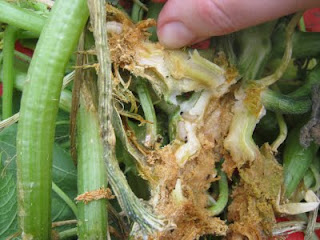UGA runs trials of vegetable seeds and publishes a list of varieties/cultivars that do well generally across the state, even with the disease and pest pressures that occur here in the Southeastern U.S. A new gardener can improve his or her odds of success by choosing at least some varieties from this list, which is included in UGA's Vegetable Planting Chart.
For example, the Better Boy hybrid tomato has the letters VFN on the seed packet. These letters indicate that the plants grown from these seeds are resistant to Verticillium wilt, Fusarium wilt, and root knot nematodes. These three problems are naturally occurring and widely distributed in Georgia's soils. All three can kill non-resistant plants. In resistant plants, infection can still occur, but the plants will grow and produce fruit in spite of the infection.
If a gardener is planning to buy plants rather than grow them from seed, looking for the VFN on the tag that comes with a plant can also be a good idea, since more varieties than just Better Boy will be resistant to those three problems. The UGA publication Georgia Home Grown Tomatoes lists more diseases for which tomatoes can be resistant and the acronyms associated with each one.
For cucumbers, the mildew diseases - both powdery mildew and downy mildew - tend to kill everyone's vines sometime in July or early August, but some of the UGA recommended varieties usually withstand the onslaught of those diseases a little longer than some other varieties.
According to Cornell University's Horticulture Department:
"Of all cucurbits, cucumbers have the most disease resistance as a result of breeding. The concern is bacterial wilt, which is spread by cucumber beetles. Beetles can be reduced by constructing tents of fine cheesecloth or using floating row covers over young transplants and seedlings. Covers do need to be removed early to mid-season to allow for pollination. If the resistant variety listed is grown, angular leaf spot (ALS), cucumber mosaic virus, powdery mildew, and downy mildew are of no concern. Slicers:Dasher II (Tolerant to ALS), Marketmore 76*, Marketmore 80*, Monarch, Salad Bush (not ALS resistant), Supersett, Trailblazer* (not ALS resistant); Pickles: Calypso, Regal, Score."The UGA publication Growing Cucumbers in the Home Garden supports that statement of insect control's making a big difference in the success of the cucumber patch. This is what it has to say about cucumber beetles:
"Control weeds, insects, and diseases for optimum yield. Cucumber beetles, aphids, mites, pickle worms, bacterial wilt, anthracnose, powdery and downy mildew, and angular leaf spot are potential problems in cucumbers. The early and continuous control of the cucumber beetle is critical to success in growing cucumbers. The cucumber beetle can infect the plant with bacterial wilt as early as the cotyledon stage, when seedlings are just emerging from the ground. Bacterial wilt causes the plants to wilt and die."The cucumber beetle comes in two varieties. The spotted version looks a lot like a ladybug. It's yellow, though, instead of red, and there is a striped cucumber beetle, too.
 |
| Squash Vine Borer larva and its damage - Photo/Amy Whitney |
Ways to get more squash before this happens include planting early-producing varieties, planting a whole lot of plants, covering the plants with row-covers in the weeks before the plants begin to bloom (so the moths that lay the eggs of the damaging larva can't get to the squash plants), and more. Most of the available techniques aren't 100% cure-alls, and they all require some advance planning.
One more-sure way around the problem is to plant a completely different species of squash. There is a variety called Zucchetta (or sometimes Trombocino) that is actually the same species as many of the winter squashes and that produces zucchini-like fruits on crazy-long vines that are very resistant to the SVBs. For gardeners who have the space and are just "done" with the SVBs, this might be a way to go.
Although it may seem (at this point) as though there are a million problems lurking in the garden waiting to decimate your crops, thinking about potential problems now and planning ways to manage them, starting with the seed and transplant choices, can make the summer harvest more abundant and the whole gardening experience more joyful.